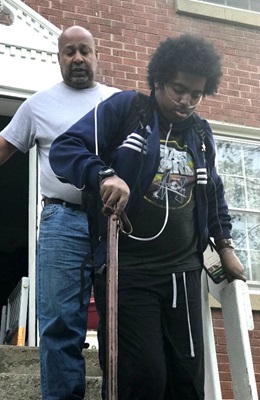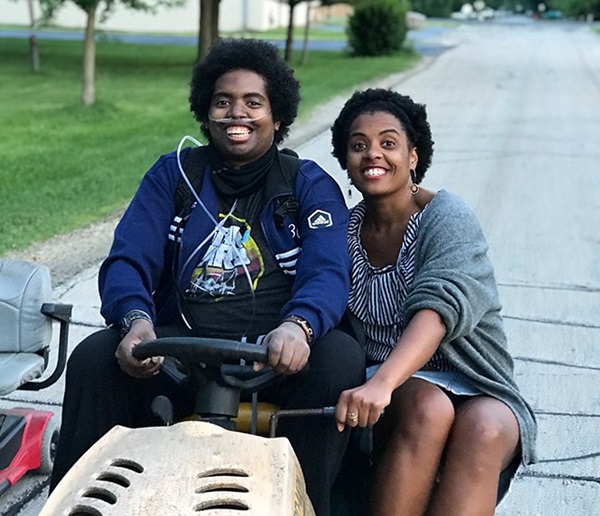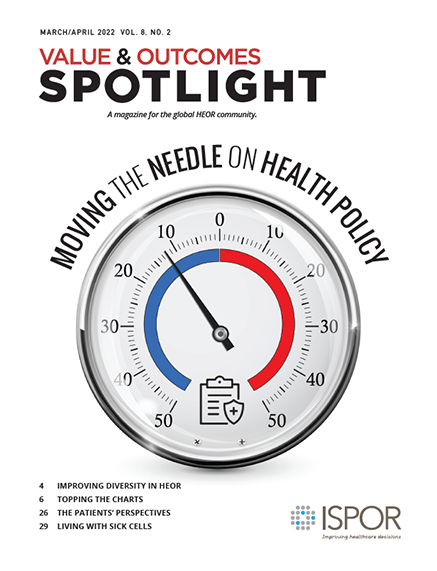Our Sickle Cell Normal: The True Cost to the Patient of Sickle Cell Disease
Ashley Valentine, MS, President and Cofounder of Sick Cells, Washington, DC, USA
I sat on the floor as the nice ladies handed my parents a black garbage bag full of wrapped gifts. Once the door latched, Marqus and I bolted to the bag and impatiently waited for our mom to start reading the labels. “Girl, age 8.”

“That’s me!” I exclaimed.
Mom continued, “Boy, age 10-14.” Marqus clutched the box to his chest, a smile stretched across his face and he met me on the floor to tear off the wrapping paper. Our mom continued to read the labels on the gifts. Marqus and I chirped back, “That’s me!” when the description of “girl” or “boy” and the age matched us. Our oldest brother, who was 16 at the time, calmly waited for his smaller, more grown-up gifts from the bag.
These are the memories that come to mind as I think about my journey as a sister to a sibling with sickle cell disease (SCD). My brother, Marqus, lived to 36 years old with SCD. He passed away June 22, 2020, during the height of the COVID-19 pandemic. We remain grateful to this day that we were allowed into the hospital to sit with him.
SCD shaped our entire lives, but it always felt like the normal way to live. SCD is a hereditary blood disease that disproportionately impacts Black and Brown people living in the United States. With the diagnosis comes the weight of stigma, prejudice, discrimination, high costs, and little access to quality care. As a result, our mother learned how to navigate the US healthcare system, thus equipping her with tools she needed to seek care for Marqus. Our family was a two-income household, had commercial insurance, and sat firmly in the middle class. Yet, no matter where we hovered in society, the disease “sickle cell” engendered other terms like “Medicaid population,” “drug seekers,” “drain on the system,” “poor people,” and even the mentality that “they don’t deserve new treatments.”
In 2016, after Marqus was accused of being a drug addict during a 6-week hospitalization, he called me and said, “Something needs to change in my lifetime.” We spent the next several years building an organization, Sick Cells, to elevate the voice of the SCD community and influence decision makers. Our vision is to empower the SCD community and show that their stories are powerful. We strive to educate various stakeholders on the spectrum of care so they understand the reality of life for someone living with SCD.
We know that only 1 in 4 patients with SCD receives the standard of care.1 According to the US Department of Health & Human Services, expenditures for patients with SCD are 6 times higher than non-SCD patients on Medicaid and 11 times higher than non-SCD patients with private insurance. It’s estimated that the United States spends $2.98 billion per year to care for people with SCD, and they are still dying in their 20s, 30s, and 40s.2 With new treatments on the market, we hoped that these statistics would change; however, as we continue to do our work, we learn that many patients experience delays in accessing new treatments as a result of utilization controls, and oftentimes the lack of a care team to prescribe the treatments.3
Marqus and I discussed these statistics during his hip replacement journey in 2018 and we decided to add up our medical expenses leading up to the procedure. The conversation began in 2017, the year we incorporated Sick Cells, when Marqus had a femoral head collapse and required a total hip replacement, 2 common complications of living with SCD. But before he could get a hip replacement, his chronic leg ulcers needed to close. To close the leg ulcers, he had to go through recurring apheresis blood exchanges; however, his port-a-cath could not tolerate the pressure of the transfusion. Every 6 weeks, Marqus went into the cath lab so an intrajugular catheter could be placed for receiving the exchange transfusion. When he got the news about his delayed hip replacement surgery and the need for frequent blood exchanges, he decided to go outside with our family dog to get air and had a fall, breaking his knee. He was too high-risk for surgery to fix the knee, so he was put on complete bed rest for a year before his hip replacement so his body could heal. Instead of budgeting just for the hip replacement, we were now budgeting for 6 conditions or procedures.
 Marqus called me daily with updates. “Ashley, the pain is bad. It’s bone against bone, but if I meditate long enough, I can get through the grocery store one time. I’ve shrunk a few inches too.” Bone-on-bone pain in his hip. Open leg ulcers on both ankles. A suture in his neck from the intrajugular catheter to complete the apheresis blood exchange, the only treatment that seemed to work on closing his leg ulcers. I’d always tease him to lighten the mood, “It takes all the specialists in the land to put Humpty Marqus back together again.”
Marqus called me daily with updates. “Ashley, the pain is bad. It’s bone against bone, but if I meditate long enough, I can get through the grocery store one time. I’ve shrunk a few inches too.” Bone-on-bone pain in his hip. Open leg ulcers on both ankles. A suture in his neck from the intrajugular catheter to complete the apheresis blood exchange, the only treatment that seemed to work on closing his leg ulcers. I’d always tease him to lighten the mood, “It takes all the specialists in the land to put Humpty Marqus back together again.”
Marqus had the hip replacement surgery on August 6, 2018. He was disabled and living with my parents. He also received $720 each month from his Social Security Insurance benefit. In order to navigate the costs of seeking care, he was on both of our parents’ insurances, and they shared medical costs. In some instances of long hospitalizations or acute situations, I contributed financially to the family medical fund or would cover other household expenses, as I did in the period leading up to the hip replacement. By July of 2018, Marqus had hit his $10,000 maximum out-of-pocket, which didn’t normally happen until November.
These out-of-pocket costs were tied to not only direct medical expenses but to indirect costs of treatment. During July, Marqus had 15 doctors’ appointments with specialists to clear each part of his body for surgery. Each visit cost them a copay ranging between $38 to $50. In July alone, they paid about $600 in copays. Most doctors’ appointments had an additional cost associated with them if any special tests, procedures, or new equipment were necessary, which they often were. For example, Marqus saw his cardiologist prior to surgery and then had to return for a stress test to make sure his heart was healthy. The copay cost $40 and so was the test, totaling $80 for that visit. On top of all the appointments, Marqus still had monthly costs of medications. He took 12 different medications every day. With their insurance, he paid about $500 a month for everything.

Other indirect costs like gas and time off from work are not typically measured when discussing value or healthcare, but they contribute substantially to monthly costs related to care. In many cases, our dad would make repeated trips to the same pharmacy because the medications were not ready when he would arrive for pickup. Our dad had to drive to 2 different pharmacies outside of Marqus’s hospital, further adding costs related to transportation. Marqus’s pain medications were at one pharmacy. His leg ulcer compound cream was at a small specialty pharmacy, the only pharmacy that could compound it. The medicine to treat his comorbidities were at CVS, and 2 other medicines to treat his SCD and prevent iron overload were mail order. Our parents or Uber took Marqus to all of his appointments.
Because our dad was an electrician and an hourly worker, he didn’t receive paid sick leave, making any time away from work an instant financial loss. Our mom was a nurse and saved her sick leave to be present at the time of the procedure. Ultimately, they decided it was more cost-effective for our dad to accept a layoff so he could get Marqus to all the presurgery appointments and coordinate his care. In July 2018, our dad made 24 trips to doctors’ appointments and around 20 trips to pharmacies.
For the major appointments, our mom stayed home from work to attend. When we totaled the hours of work our parents missed in July 2018 to prepare for this surgery, my dad lost a total of 160 hours and my mom lost 30 hours. We didn’t total the money spent on eating out, groceries, the water budget (because people with SCD have to stay extra-hydrated), or my flights back and forth to Illinois to help out at home. On average, a 2009 estimate stated that someone with sickle cell would spend $460,000 or more over their lifetime for care.4 Our family can easily say that statistic is true.
 But before we became advocates, or had a nonprofit, or even had the words to describe how others viewed us with this diagnosis, this was what we did. Sickle cell was our normal. Medical bills and prescription costs came first. Marqus needed it and so did the rest of us when we also got sick. Sometimes the lights or gas were turned off; our house was foreclosed 5 times in the course of my lifetime. My mom would let us use the Blue Cross Blue Shield bills as kindling for bonfires and we mapped out hospital emergency rooms before any vacation we ever took. When Marqus would go into a pain crisis at night, we would all gather in my parents’ bed and rub his legs because, truthfully, pain medications are just a Band-Aid, not a disease-modifying treatment. We also lived between the crises. I rode horses. We went to Scotland on a family vacation. Marqus was manager for all the school sports teams. All 3 of us kids played music and took lessons near Marqus’s children’s hospital. Marqus’s hospital appointments and admissions in Chicago meant 25-cent wing nights at the chicken wing spot down the street. From my perspective, we had our version of a normal life.
But before we became advocates, or had a nonprofit, or even had the words to describe how others viewed us with this diagnosis, this was what we did. Sickle cell was our normal. Medical bills and prescription costs came first. Marqus needed it and so did the rest of us when we also got sick. Sometimes the lights or gas were turned off; our house was foreclosed 5 times in the course of my lifetime. My mom would let us use the Blue Cross Blue Shield bills as kindling for bonfires and we mapped out hospital emergency rooms before any vacation we ever took. When Marqus would go into a pain crisis at night, we would all gather in my parents’ bed and rub his legs because, truthfully, pain medications are just a Band-Aid, not a disease-modifying treatment. We also lived between the crises. I rode horses. We went to Scotland on a family vacation. Marqus was manager for all the school sports teams. All 3 of us kids played music and took lessons near Marqus’s children’s hospital. Marqus’s hospital appointments and admissions in Chicago meant 25-cent wing nights at the chicken wing spot down the street. From my perspective, we had our version of a normal life.
Marquis hopes that the next generation of families living with SCD will not have to suffer so much. He hopes that future patients will have medication to treat their SCD and can have access to high-quality care, access to providers who are educated about their condition, access to robust coverage for treatments and therapies, they can live long lives.
References
1. Office of the Assistant Secretary of Health. Sickle cell disease. Published November 9, 2020. Accessed March 14, 2022.
2. Huo J, Xiao H, Garg M, Shah C, Wilkie DJ, Mainous III A. The economic burden of Sickle Cell Disease in the United States. Value Health. 2018;21(Supp 2):S108.
3. Sick Cells. Advancing Stakeholder Engagement with Medicaid: Centering the Patient Voice in Coverage Decisions. Published March 2022. Accessed March 14, 2022.
4. Kauf TL, Coates TD, Huazhi L, Mody-Patel N, Hartzema AG. The cost of healthcare for children and adults with sickle cell disease. Am J Hematol. 2009;84(6):323-332.
Explore Related HEOR by Topic

